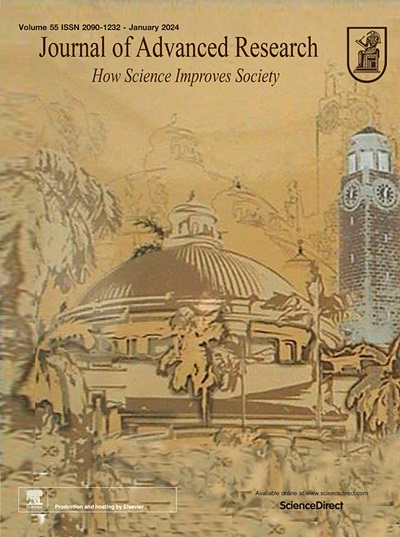A 3R-MYB transcription factor is involved in Methyl Jasmonate-Induced disease resistance in Agaricus bisporus and has implications for disease resistance in Arabidopsis
IF 13
1区 综合性期刊
Q1 MULTIDISCIPLINARY SCIENCES
引用次数: 0
Abstract
Introduction
Methyl jasmonate (MeJA) and MYB transcription factors (TFs) play important roles in pathogen resistance in several plants, but MYB TFs in conjunction with MeJA-induced defense against Pseudomonas tolaasii in edible mushrooms remain unknown.
Objectives
To investigate the role of a novel 3R-MYB transcription factor (AbMYB11) in MeJA-induced disease resistance of Agaricus bisporus and in the resistance of transgenic Arabidopsis to P. tolaasii.
Methods
Mushrooms were treated with MeJA alone or in combination with phenylpropanoid pathway inhibitors, and the effects of the treatments on the disease-related and physiological indicators of the mushrooms were determined to assess the role of MeJA in inducing resistance and the importance of the phenylpropanoid pathway involved. Subcellular localization, gene expression analysis, dual-luciferase reporter assay, electrophoretic mobility shift assay, and transgenic Arabidopsis experiments were performed to elucidate the molecular mechanism of AbMYB11 in regulating disease resistance.
Results
MeJA application greatly improved mushroom resistance to P. tolaasii infection, and suppression of the phenylpropanoid pathway significantly weakened this effect. MeJA treatment stimulated the accumulation of phenylpropanoid metabolites, which was accompanied by increased the activities of biosynthetic enzymes and the expression of phenylpropanoid pathway-related genes (AbPAL1, Ab4CL1, AbC4H1) and an AbPR-like gene, further confirming the critical role of the phenylpropanoid pathway in MeJA-induced responses to P. tolaasii. Importantly, AbMYB11, localized in the nucleus, was rapidly induced by MeJA treatment under P. tolaasii infection; it transcriptionally activated the phenylpropanoid pathway-related and AbPR-like genes, and AbMYB11 overexpression in Arabidopsis significantly increased the transcription of phenylpropanoid-related genes, the accumulation of total phenolics and flavonoids, and improved resistance to P. tolaasii.
Conclusion
This study clarified the pivotal role of AbMYB11 as a regulator in disease resistance by modulating the phenylpropanoid pathway, providing a novel idea for the breeding of highly disease-resistant edible mushrooms and plants.

3R-MYB转录因子参与了茉莉酸甲酯诱导的双孢蘑菇抗病性,并对拟南芥的抗病性产生了影响。
引言:茉莉酸甲酯(MeJA)和 MYB 转录因子(TFs)在多种植物的病原体抗性中发挥着重要作用,但 MYB TFs 与 MeJA 诱导的食用菌对假单孢菌(Pseudomonas tolaasii)的防御作用的关系仍不清楚:目的:研究新型 3R-MYB 转录因子(AbMYB11)在 MeJA 诱导的双孢蘑菇抗病性以及转基因拟南芥对 P. tolaasii 的抗性中的作用:方法:用MeJA单独或与苯丙酮途径抑制剂联合处理蘑菇,测定处理对蘑菇病害相关指标和生理指标的影响,以评估MeJA在诱导抗性中的作用以及参与其中的苯丙酮途径的重要性。通过亚细胞定位、基因表达分析、双荧光素酶报告实验、电泳迁移实验和转基因拟南芥实验,阐明了AbMYB11调控抗病性的分子机制:结果:MeJA的应用大大提高了蘑菇对P. tolaasii感染的抗性,而苯丙氨酸途径的抑制则显著削弱了这种效应。MeJA处理刺激了苯丙类代谢物的积累,同时也提高了生物合成酶的活性和苯丙类途径相关基因(AbPAL1、Ab4CL1、AbC4H1)及一个类AbPR基因的表达,进一步证实了苯丙类途径在MeJA诱导的抗P.重要的是,AbMYB11定位于细胞核中,在拟南芥感染P. tolaasii后被MeJA处理迅速诱导;它转录激活了苯丙类途径相关基因和AbPR样基因,在拟南芥中过表达AbMYB11显著增加了苯丙类相关基因的转录、总酚类和类黄酮的积累,并提高了对P. tolaasii的抗性:本研究阐明了 AbMYB11 通过调节苯丙氨酸途径在抗病性中的关键作用,为培育高抗病性食用菌和植物提供了新思路。
本文章由计算机程序翻译,如有差异,请以英文原文为准。
求助全文
约1分钟内获得全文
求助全文
来源期刊

Journal of Advanced Research
Multidisciplinary-Multidisciplinary
CiteScore
21.60
自引率
0.90%
发文量
280
审稿时长
12 weeks
期刊介绍:
Journal of Advanced Research (J. Adv. Res.) is an applied/natural sciences, peer-reviewed journal that focuses on interdisciplinary research. The journal aims to contribute to applied research and knowledge worldwide through the publication of original and high-quality research articles in the fields of Medicine, Pharmaceutical Sciences, Dentistry, Physical Therapy, Veterinary Medicine, and Basic and Biological Sciences.
The following abstracting and indexing services cover the Journal of Advanced Research: PubMed/Medline, Essential Science Indicators, Web of Science, Scopus, PubMed Central, PubMed, Science Citation Index Expanded, Directory of Open Access Journals (DOAJ), and INSPEC.
 求助内容:
求助内容: 应助结果提醒方式:
应助结果提醒方式:


